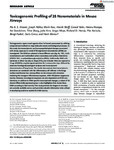Toxicogenomic Profiling of 28 Nanomaterials in Mouse Airways
| dc.contributor.author | Kinaret, PAS | |
| dc.contributor.author | Ndika, J | |
| dc.contributor.author | Ilves, M | |
| dc.contributor.author | Wolff, H | |
| dc.contributor.author | Vales, G | |
| dc.contributor.author | Norppa, H | |
| dc.contributor.author | Savolainen, K | |
| dc.contributor.author | Skoog, T | |
| dc.contributor.author | Kere, J | |
| dc.contributor.author | Moya, S | |
| dc.contributor.author | Handy, Richard | |
| dc.contributor.author | Karisola, P | |
| dc.contributor.author | Fadeel, B | |
| dc.contributor.author | Greco, D | |
| dc.contributor.author | Alenius, H | |
| dc.date.accessioned | 2021-05-12T17:12:42Z | |
| dc.date.available | 2021-05-12T17:12:42Z | |
| dc.date.issued | 2021-03-08 | |
| dc.identifier.issn | 2198-3844 | |
| dc.identifier.issn | 2198-3844 | |
| dc.identifier.other | ARTN 2004588 | |
| dc.identifier.uri | http://hdl.handle.net/10026.1/17115 | |
| dc.description.abstract |
<jats:title>Abstract</jats:title><jats:p>Toxicogenomics opens novel opportunities for hazard assessment by utilizing computational methods to map molecular events and biological processes. In this study, the transcriptomic and immunopathological changes associated with airway exposure to a total of 28 engineered nanomaterials (ENM) are investigated. The ENM are selected to have different core (Ag, Au, TiO<jats:sub>2</jats:sub>, CuO, nanodiamond, and multiwalled carbon nanotubes) and surface chemistries (COOH, NH<jats:sub>2</jats:sub>, or polyethylene glycosylation (PEG)). Additionally, ENM with variations in either size (Au) or shape (TiO<jats:sub>2</jats:sub>) are included. Mice are exposed to 10 µg of ENM by oropharyngeal aspiration for 4 consecutive days, followed by extensive histological/cytological analyses and transcriptomic characterization of lung tissue. The results demonstrate that transcriptomic alterations are correlated with the inflammatory cell infiltrate in the lungs. Surface modification has varying effects on the airways with amination rendering the strongest inflammatory response, while PEGylation suppresses toxicity. However, toxicological responses are also dependent on ENM core chemistry. In addition to ENM‐specific transcriptional changes, a subset of 50 shared differentially expressed genes is also highlighted that cluster these ENM according to their toxicity. This study provides the largest in vivo data set currently available and as such provides valuable information to be utilized in developing predictive models for ENM toxicity.</jats:p> | |
| dc.format.extent | 2004588- | |
| dc.format.medium | Electronic-eCollection | |
| dc.language | en | |
| dc.language.iso | en | |
| dc.publisher | Wiley | |
| dc.rights | Attribution-NonCommercial-NoDerivatives 4.0 International | |
| dc.rights | Attribution-NonCommercial-NoDerivatives 4.0 International | |
| dc.rights | Attribution-NonCommercial-NoDerivatives 4.0 International | |
| dc.rights | Attribution-NonCommercial-NoDerivatives 4.0 International | |
| dc.rights | Attribution-NonCommercial-NoDerivatives 4.0 International | |
| dc.rights.uri | http://creativecommons.org/licenses/by-nc-nd/4.0/ | |
| dc.rights.uri | http://creativecommons.org/licenses/by-nc-nd/4.0/ | |
| dc.rights.uri | http://creativecommons.org/licenses/by-nc-nd/4.0/ | |
| dc.rights.uri | http://creativecommons.org/licenses/by-nc-nd/4.0/ | |
| dc.rights.uri | http://creativecommons.org/licenses/by-nc-nd/4.0/ | |
| dc.subject | airway exposure | |
| dc.subject | immunotoxicity | |
| dc.subject | nanomaterials | |
| dc.subject | nanoparticles | |
| dc.subject | nanotoxicology | |
| dc.subject | toxicogenomics | |
| dc.subject | transcriptomics | |
| dc.title | Toxicogenomic Profiling of 28 Nanomaterials in Mouse Airways | |
| dc.type | journal-article | |
| dc.type | Journal Article | |
| dc.type | Research Support, Non-U.S. Gov't | |
| plymouth.author-url | https://www.webofscience.com/api/gateway?GWVersion=2&SrcApp=PARTNER_APP&SrcAuth=LinksAMR&KeyUT=WOS:000626558100001&DestLinkType=FullRecord&DestApp=ALL_WOS&UsrCustomerID=11bb513d99f797142bcfeffcc58ea008 | |
| plymouth.issue | 10 | |
| plymouth.volume | 8 | |
| plymouth.publication-status | Published | |
| plymouth.journal | Advanced Science | |
| dc.identifier.doi | 10.1002/advs.202004588 | |
| plymouth.organisational-group | /Plymouth | |
| plymouth.organisational-group | /Plymouth/Faculty of Science and Engineering | |
| plymouth.organisational-group | /Plymouth/Faculty of Science and Engineering/School of Biological and Marine Sciences | |
| plymouth.organisational-group | /Plymouth/REF 2021 Researchers by UoA | |
| plymouth.organisational-group | /Plymouth/REF 2021 Researchers by UoA/UoA06 Agriculture, Veterinary and Food Science | |
| plymouth.organisational-group | /Plymouth/Research Groups | |
| plymouth.organisational-group | /Plymouth/Research Groups/Marine Institute | |
| plymouth.organisational-group | /Plymouth/Users by role | |
| plymouth.organisational-group | /Plymouth/Users by role/Academics | |
| dc.publisher.place | Germany | |
| dcterms.dateAccepted | 2021-01-26 | |
| dc.rights.embargodate | 2021-5-15 | |
| dc.identifier.eissn | 2198-3844 | |
| dc.rights.embargoperiod | Not known | |
| rioxxterms.versionofrecord | 10.1002/advs.202004588 | |
| rioxxterms.licenseref.uri | http://creativecommons.org/licenses/by-nc-nd/4.0/ | |
| rioxxterms.licenseref.startdate | 2021-03-08 | |
| rioxxterms.type | Journal Article/Review | |
| plymouth.funder | NANOSOLUTIONS Biological Foundation for the Safety Classification of Engineered Nanomaterials (ENM): Systems Biology Approaches to Understand::European Commission FP7 |



